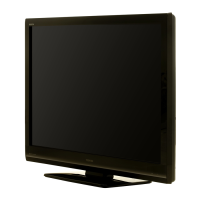
Do you have a question about the Toshiba 42XV550A_560A and is the answer not in the manual?
| Screen Size | 42 inches |
|---|---|
| Display Type | LCD |
| Response Time | 8 ms |
| HDMI Ports | 3 |
| USB Ports | 1 |
| Backlight | CCFL |
| Component Video Inputs | 1 |
| Composite Video Inputs | 1 |
| Refresh Rate | 50 Hz |
| Resolution | 1920 x 1080 pixels |
| Brightness | 500 cd/m2 |
| Display Technology | LCD |
| Viewing Angle | 178 degrees |
| Input Ports | HDMI, Component, Composite, USB |
| Sound Output | 10W x 2 |
Welcome message and overview of the manual's purpose for new TV owners.
Essential safety and operating instructions to ensure safe use of the TV.
Guidelines for safely installing the TV, including power, placement, and stability.
Precautions for TV placement, preventing damage, and general safe usage practices.
Instructions regarding self-repair, malfunctions, and end-of-life disposal.
Procedures for safely cleaning the TV cabinet and LCD screen.
Notes on LCD screen care, pixel behaviour, interference, and operational conditions.
Instructions for connecting an aerial for optimal TV reception.
Guide to installing remote control batteries and understanding effective range.
Procedure for automatically scanning and storing all available TV channels.
How to manually tune analogue TV channels for specific positions.
Methods for navigating and viewing digital TV programmes.
How to manually change the current channel position.
Quickly switching between two previously viewed channels.
How to choose the display language for the on-screen menus.
Guide to selecting and adjusting picture size for optimal viewing.
Improves the definition of dark areas in the picture.
Enhances motion smoothness for 24fps content like movies.
Adjusts and improves the smoothness of motion.
Eliminates motion blur without affecting brightness.
Adjusts the warmth or coolness of the picture.
Automatically adjusts screen brightness for dark scenes.
Automatically recognizes stereo/bilingual broadcasts or selects Mono.
Allows selection of Dual 1 or Dual 2 sound for bilingual programmes.
Adjusts Bass, Treble, and Balance for optimal sound quality.
Enhances sound experience with SRS 3D, FOCUS, and TruBass technologies.
Limits volume changes to prevent sudden shifts between content.
Boosts bass levels for a richer sound experience.
Turns screen blue and mutes sound when no signal is received.
Stretches 4:3 format programmes into a full screen picture.
Adjusts the brightness of the side panels in 14:9 or 4:3 modes.
Disables physical buttons on the TV while retaining remote control functionality.
Sets the TV to go to a specific channel at a certain time.
Allows the TV to automatically turn itself off after a set period.
Enable and configure REGZA-LINK features and system audio.
Automatically switch TV input and power on connected devices.
Synchronize standby mode between TV and connected devices.
How to select between Auto and List modes for teletext viewing.
Displaying and navigating the electronic programme guide for TV listings.
Creating and managing lists of favourite TV and radio channels.
Searching programmes based on selected genres within the EPG.
Creating and managing lists of favourite digital channels.
Restricting access to digital channels, requiring a PIN.
Establishing a four-digit PIN for parental control and locked channels.
Diagram and explanation of connection examples for back panel terminals.
How to connect the TV to an audio system for high-quality sound.
Connecting to an amplifier with a Dolby Digital decoder via optical digital audio.
Connecting an HDMI device using an HDMI cable.
Connecting a DVI device using an HDMI-to-DVI adapter cable.
Connecting a PC using an analogue RGB (15-pin) cable.
Connecting a PC via HDMI using an HDMI cable or adapter.
Adjusting picture size and position when connected via PC.
Synchronizing PC signal and LCD display for a clear picture.
Optimizing picture detail, screen width, and vertical lines for PC input.
Restores PC settings to their factory default values.
Solutions for common TV symptoms like no picture, no sound, or poor reception.
